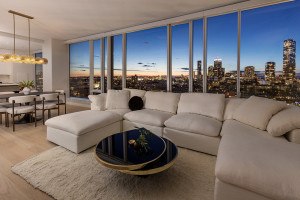Q&A: Interior Designer Liz Caan

Liz Caan considers fabric and wallpaper samples in her Newton studio. / Photograph by Joyelle West, hair and makeup by Paula Voisembert/Team
Newton-based Liz Caan has been practicing interior design for more than a decade. Because we love her bespoke approach, we sat down with her to find out how she works.
When should a homeowner hire an interior designer?
Generally our role is to work with the client and architect to put together finish schedules, as well as hardware and plumbing and all of the decorative lights. We have furniture plans baked in before we start building, so we can put all of the lighting in exactly the right spot. We deal with a lot of automation, too, which we can build in when we’re brought in at the beginning. So calling us early saves people a lot of money, and it makes a better home.
Should a client scour the Web for images before calling you?
It’s always helpful when clients have a general idea of what they like and don’t like, so it’s nice when people can show us things. In the beginning of the design process, magazine tears, Pinterest, Houzz, and shared iCloud folders with screen shots can help clients communicate an idea, but when we get going, it becomes distracting because you’re constantly going to see something new.
What happens if a client gets hooked on Pinterest?
They want to start changing things—switching direction midstream—and that’s not a good way to design. At some point you have to trust the process. When we design, it’s not about individual items; we’re not shoppers trying to find things to fill a room. A house is really about a story in which everything speaks to each other. That’s different from trying to make 500 little things work together.
How do you develop a story after looking at your clients’ images?
I usually ask people to go through their photos with me and explain what’s attracting them to this or that. A lot of their images then get thrown out because they don’t even remember why they pinned them. That’s the problem with technology: We don’t have to be thoughtful about it. Instead, you have to think. Don’t just pin everything.
Then I refocus our process on the space, location, light, and architecture. As a designer, I ask, What does the space want to be? You’re trying to create a feeling. You think of those words, which become the story: It’s natural, bright, happy, and feels handmade, cumulated and collected, kind of messy. Then you start sourcing for those things that support the feeling that you’re trying to evoke.
Where do you find inspiration?
I go to my books. If you come to my house, you have to sit on books because I have more books than furniture.
How is learning design from books different from studying Pinterest?
In the design books you can actually read about where the idea came from. Most good design is a solution: You’re trying to make things work together in a space, or you need a specific amount of seating, or you have a tight area to work with. Most things have been thought of, so it’s a matter of how you put together ideas to make a new idea. When you’re just pinning images, you’re not understanding the backstory. It’s just a pretty picture.
You and I have both noticed the dearth of books in other people’s homes.
I feel like a lot of people don’t have books. I know that because we build bookshelves that need to be filled. The lack of books is amazing to me.
What do you do with those built-ins?
You need a lot of stuff to fill a bookshelf. Sometimes it can cost more to fill them than they cost to make. We once did a living room and family room for a client, and they had a lot of built-ins. After we finished our installation, they were having a party, but the shelves were bare. So we said, Why don’t we just accessorize your whole house and fill all of those shelves? After the party, you can buy whatever you want and we’ll come get the rest. They kept everything. Now when the cleaning people come, the family has them take a picture with their phones so that when they dust, they can put it all back the way it should be.
Do people think they have more stuff than they really do?
I have never had a client who had too much stuff for a bookshelf, ever. They’re fixating on the length of the bookshelf, not thinking about how they’ll fill it. Some people actually have book collections. But a lot of people don’t, or they buy houses that have all these shelves and they’re like, What are we going to do?
What’s the most-requested home feature that people don’t need?
About 90 percent of my clients want to build a homework room. I think they imagine that all of their children are going to come home from school and put all of their things in their perfect mudroom, close the locker door, and go into the homework room, sit down, do their homework, excel at school, and it’s going to be perfect. And as a parent, I will tell you, none of that happens. Ever.
Where do kids actually work?
Most younger kids want to be with their parents. They want to sit at the kitchen island or table, near where their parents are prepping a meal or working from home. When they get older, kids want to hide in their room; they work on their bed or the floor. My answer to the homework room: Build a nice big island where they can have a snack and get it over with so they can go play.
Have attitudes toward interior design changed over the past 10 years?
People want things immediately, and they don’t realize how much things cost. Retail has come a long way and design is accessible for so many people, so sure, you could slap together a house. I’m not sure it would be really interesting, but it might photograph well.
Clients will show me things that are beautiful, and I’ll say, yes, it’s a really photogenic chair, but it’s made of cardboard—there are no springs, there’s no down filling, there’s not a natural material in there. It just took a good picture. You rely on a designer to steer you in the right direction because it’s a big investment.
Why do you favor custom pieces from local craftspeople?
I like it when my clients can meet the people making things for their house. It’s an experience they can share. I’ve sent clients to our vendors so they can appreciate that their furniture and lighting are made by hand in the U.S. Many designers talk about “bespoke,” but it’s really bespoke when you can shake the hand of the people who made the things in your home. It’s about supporting local businesses and being able to customize things. All those people who touched your piece—from building the frame to upholstering it—live in Massachusetts, pay taxes, and earn a living. That’s why we can’t compete with mass-market retailers, but I can stand behind the things that we sell. You know they’re going to last.


